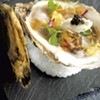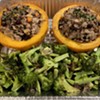Friday, July 13, 2012
Grazing: Cooling Ceviche at El Cortijo
Posted
By Corin Hirsch
on Fri, Jul 13, 2012 at 5:51 PM
It's hot. Way too hot to use a stove, and maybe even a grill. So what's for dinner, besides another salad? Ceviche! Even though I just had it for lunch yesterday and will probably have it again tomorrow, and next week.
Think of it as Mexican chirashi. This colorful tangle of fresh fish, citrus juice, peppers and cilantro is a culinary miracle in that it usually requires no heat: By marinating the fish in lemon or lime juice for a few hours, you let the acids firm up and "cook" the fish. The end product is silky, cooling and spiked with the right kind of heat (peppers).
I first had ceviche when I was 14, when an uncle whipped it together with some abalone he had caught that day off the coast of southern California. It was such an unfamiliar jumble of flavors and textures that it took me a while to warm to it. But all grown up, I'm frustrated there isn't more of it here.
El Gato has it on weekends. If you're an addict, though, one place you can land it every day is El Cortijo Taquería y Cantina, where chef Phillip Clayton most recently made it with tiny, sweet Maine shrimp; chopped ribbons of young calamari; lemon and lime juices; a hint of cilantro and dots of red onion and jalapeño pepper. The dressing barely kisses the fish, and the whole thing manages to be light, zingy and filling at the same time.
Once again, the chef graciously shared his recipe, and, as with most great restaurant dishes, what seems so simple is actually rather complex. Clayton applies some heat to the fish first — in the form of poaching — but endorses the use of fresh fish if it's totally, completely fresh. Though the dish is Mexican at its heart, he includes a few French touches: thyme and a splash of white wine. These portions would feed a party, so size down accordingly. And, if you're feeling lazy from the heat, just melt onto a stool at El Cortijo and try it yourself.
Ceviche, El Cortijo-Style
Courtesy of chef Phillip Clayton
This recipe can be prepared with either cooked or raw fish. If you are using raw fish, it must be absolutely fresh and sushi-grade, and from a reputable source. Depending on the variety, it can be cut different ways — the most common being a small dice, which is 1/4 inch x 1/4 inch x 1/4 inch. I prefer responsibly sourced fish from the Northeast. One of the best regionally local fish that can be eaten raw is fluke flounder; around these parts we usually get it from Maine. If you can’t find very fresh fish, you can substitute cooked fish. We use cooked calamari and Maine shrimp at El Cortijo for several reasons: consistency and quality of supply; responsible/known source; consistency of preparation; overall quality of the finished product. You can also dice fish of your choice and either add it to the shrimp and calamari or substitute it for either.
Also, this batch size has not been tested. Consider this more procedural than exact. You can make ceviche “your own” by adjusting spice levels, acidity, and salt. It’s better to start lower with things like salt and adjust it to your liking. If you like cilantro, add more cilantro; if you like onions, add more onions. Know what I mean? Ceviche is interpretive; the most important thing is the quality of your ingredients, and the rest is up to you.
So…
For the pico de gallo:
This recipe probably makes a lot more than you’ll need for the ceviche, but it’s a good pairing.
6 medium-sized ripe tomatoes, diced (my favorite are from Trillium Hill Farm in Hinesburg)
1 small red onion, minced
1 tablespoon fresh garlic, minced
2 jalapeños, minced with seeds included
Half a bunch cilantro, fine chiffonade
1 tablespoon salt (or to taste; the ceviche is seasoned later)
2 tablespoons fresh lime juice
Combine all ingredients and let sit at room temperature while you prepare the rest. The pico can be made a day in advance and stored in the refrigerator, but you should allow it to warm to room temperature before using. Tomatoes taste way better at room temperature.
For the fish:
Prepare the fish by slicing the calamari and shrimp into small pieces. Pay careful attention to slicing the calamari tubes; the thinner the better. We use small Maine shrimp, so they only need to be cut in half, but if using large shrimp, slice lengthwise, and then cut in half.
For the court bouillon:
1 bottle dry white wine
1 gallon water
Half a bunch thyme
1 tablespoon peppercorns
1 teaspoon chili flake
2 bay leaves
3 lemons, sliced
1/2 cup kosher salt
Combine all ingredients in a nonreactive (stainless steel) stock pot, and bring to a low simmer. It is important to use stainless steel, because cheaper materials can react negatively to the high acidity in the court bouillon and create a bitter, metallic taste.
Prepare an ice bath (large bowl of water with lots of ice, big enough to fit a strainer down into the ice water).
Poach each fish individually by placing a strainer into the simmering court bouillon and then adding the fish. It is important to poach them separately because each fish cooks at a different rate. The fish should be poached until it is just barely cooked through. If the fish is overcooked, it will be chewy.
Immediately shock the fish in the ice water by removing the strainer from the court bouillon and submerging it in the ice water. Once the fish is completely cooled, remove it from the ice bath, drain, then place the fish in a bowl. Allow the court bouillon to return to a simmer before poaching the next round of fish. All of the fish can be combined after cooking.
For the ceviche:
2 cups fish
3/4 cup pico
3 tablespoons extra virgin olive oil (we use arbequina, which is a Spanish variety grown in California. It’s a fantastic domestic olive oil.)
1 teaspoon kosher salt to start, and then season to taste
2 tablespoons fresh lime juice, adjust to taste
Combine all ingredients and let sit for a few minutes. You can serve it one of two ways. I like both, but we serve it “tight” at Cortijo for the sake of presentation.
To serve it soupy, leave it in the bowl and serve. To serve it "tight," scoop it out of the bowl with your hands, leaving behind some juice. Arrange on a plate and drizzle with a little more olive oil.
Serve with tortilla chips (preferably warm).
You can also serve it with sliced cucumbers instead of chips.
Comments
Comments are closed.
Since 2014, Seven Days has allowed readers to comment on all stories posted on our website. While we’ve appreciated the suggestions and insights, the time has come to shut them down — at least temporarily.
While we champion free speech, facts are a matter of life and death during the coronavirus pandemic, and right now Seven Days is prioritizing the production of responsible journalism over moderating online debates between readers.
To criticize, correct or praise our reporting, please send us a letter to the editor. Or send us a tip. We’ll check it out and report the results.
Online comments may return when we have better tech tools for managing them. Thanks for reading.
One or more images has been removed from this article. For further information, contact
[email protected].















































